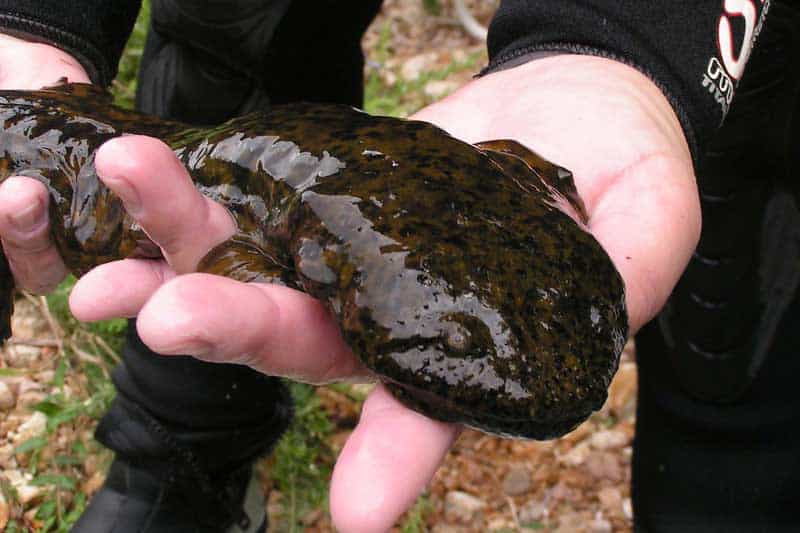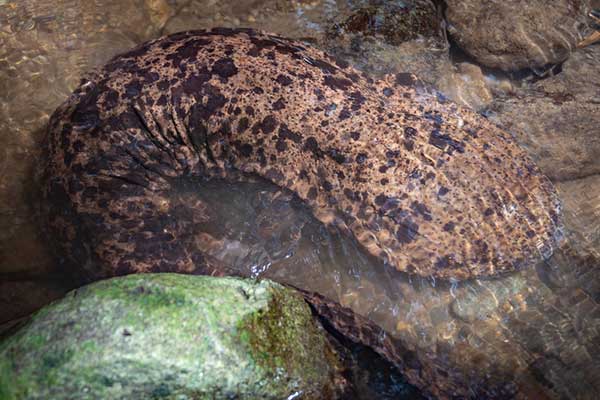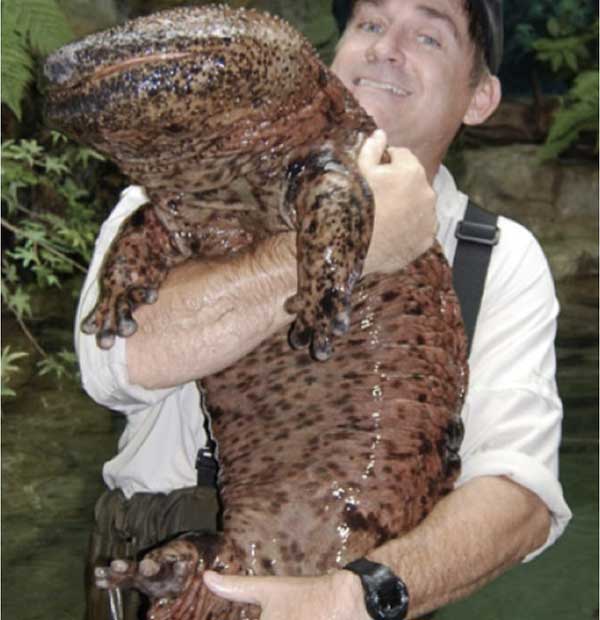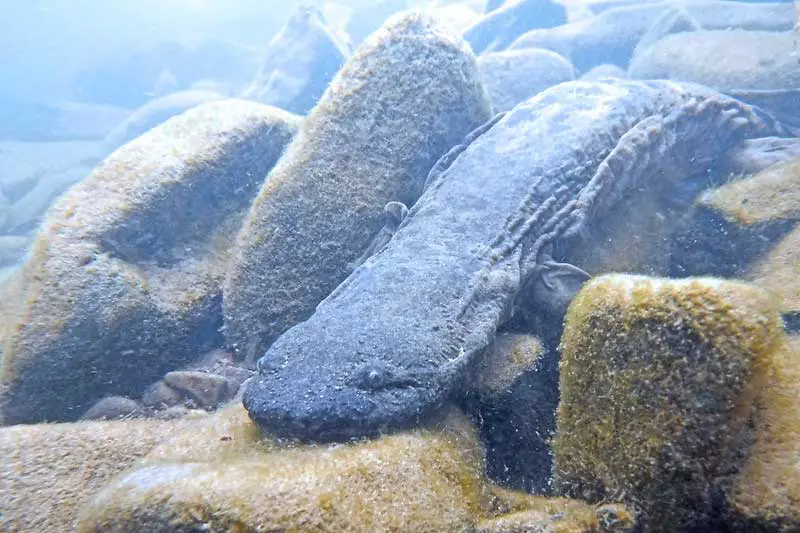As their name suggests, giant salamanders are the largest species of salamanders globally. All 3 giant salamanders belong to the Cryptobranchid family, which are fully aquatic. This group of salamanders diverged from their relatives over 170 million years ago during the Jurassic period.
Salamanders breathe through their skin, with their wrinkles and skin slaps increasing the surface area for respiration. They absorb oxygen from the water and enjoy living in areas of fast-running mountain streams with high oxygen levels. Although they have a lung, it is mainly there to help them float in water.
Giant salamanders live a long time and have amazing regenerative abilities. They can easily re-grow their skin and bone. Let’s learn more about the 3 giant salamanders on earth.
Giant Salamanders
The 3 species of giant salamanders are the Hellbender, Japanese giant salamander, and Chinese giant salamander.
1. Hellbender

Scientific name: Cryptobranchus alleganiensis
Adult length: 20 – 29 inches
The Hellbender is the only giant salamander in North America. It is also the only animal in the genus Cryptobranchus. They generally live under boulders or large rocks partially buried in fast-flowing, cold streams.
There are two subspecies of Hellbenders in the U.S. The Ozark Hellbender (Cryptobranchus alleganiensis bishopi) lives in the rivers of Arkansas and Missouri. The Eastern Hellbender (Cryptobranchus alleganiensis alleganiensis) lives throughout the Appalachian region, Kentucky, Indiana, Illinois, Ohio, and Missouri.
Hellbenders have a paddle-shaped tail, flat heat, and wrinkled dark gray or brown body with irregular spots. They average 29 inches in length and can grow up to 29 inches. The largest North American salamander by weight, they reach up to 5 pounds.
Females lay between 100 to 500 eggs that males externally fertilize and guard until they hatch after around two months. However, the Ozark Hellbenders are federally endangered. The U.S. Fish & Wildlife Service is still evaluating the conservation status of the Eastern Hellbender.
Fun Facts:
- Captive Hellbenders live up to 29 years, but wild ones can live over 50 years.
- They are sometimes called “snot otters.”
- You can confuse them with mudpuppies. However, Hellbenders don’t have gills.
- Adult Hellbenders can be eaten by minks, raccoons, and river otters.
- Its large moth allows Hellbenders to eat animals almost as big as itself.
2. Japanese Giant Salamander

Scientific name: Andrias japonicus
Adult length: up to 5 feet
Japanese giant salamanders live in Japan’s fast-flowing, rocky streams in the central highland mountainous areas. Some also live in the southern islands of Japan. Their breeding season is from August to October, when they migrate upriver looking for burrows or caverns as dens. However, their conservation status is near threatened.
They are the second-largest species globally, growing up to 5 feet in length and 55 pounds. They have wrinkled skin with various patterns of brown and black. There are no differences in appearances between males and females except during the breeding season when the males develop an enlarged cloaca.
These salamanders have tiny teeth and strong jaw pressure to capture prey, such as fish, crayfish, and small mammals in their mouth. They also secrete toxic mucus when they are stressed or aggravated. Their secretion has a strong smell like Japanese peppers, giving them the common Japanese name translating to “big pepper fish.”
Fun Facts:
- They can live for over 70 years.
- They are nocturnal and, during the day, they hide along the water’s edge under large rocks.
- Japanese giant salamanders have a slow metabolism and can go weeks without eating.
- Their poor eyesight means they rely on smell and vibrations in the water to hunt.
- Males are sometimes called “den masters” since it’s their job to protect eggs as they develop and hatch.
- Japan designated them as a special natural monument in 1952, so hunting them is illegal.
3. Chinese Giant Salamander

Scientific name: Andrias davidianus
Adult length: 3.5 – 6 feet
The Chinese Giant Salamander lives underwater in China’s freshwater river ecosystems. They are the largest living amphibian globally, growing close to 6 feet long. Young Chinese Giant Salamanders reach maturity around five years of age and are 16 to 20 inches in length.
These salamanders have wrinkly dark brown skin with speckled patterns. They can also be black, dark reddish, or Albinos that are white or orange. They eat snails, crabs, fish, frogs, and sometimes smaller salamanders using a suction technique. You can hear them hissing, whining, barking, or making a crying sound resembling a baby’s cry.
This species is on the Evolutionarily Distinct and Globally Endangered (EDGE) species list and identified as the amphibian needing conservation the most. People have taken them from the wild and farmed them for Chinese medicine and luxury foods.
Fun Facts:
- They can live over 60 years in managed care and longer in the wild.
- This species diverged between 3.1 and 2.4 million years ago.
- One of their oldest known fossils is from the Middle Jurassic of China.
- Their crying sound has given them the nickname “baby fish.”
- They have gills as larvae, but lose them early on as they grow.
- Females lay between 400 to 500 eggs that males look after until hatching.



